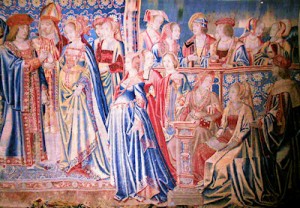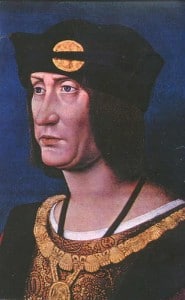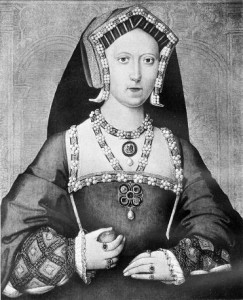
Chronicler Edward Hall recorded Mary’s entry into Abbeville on 8th October and then the marriage on 9th:
“[…she was with great triumphe, procession & pagiantes receyued into the toune of Abuyle the viii. daye of October by the Dolphin, which recyued her with great honor, she was appareilled in cloth of siluer, her horse was trapped in goldsmythes work very rychly. After her folowed xxxvi. ladies, al ther palfreys trapped with crymsyn veluet, embraudered: after them folowed one charyott of clothe of tyssue, the seconde clothe of golde and the third Crymsyn veluet embrawdered with the kyngs armes & hers, full of roses. After them folowed a great nomber of archers, and then wagons laden with their stuf. Great was the riches in plate, iuels [jewels], money, apparel, and hangynges that this lady brought into France.
The Monday beyng the daye of Saincte Denyse, thesame kynge Lewes married the lady Mary in the great church of Abuyle, bothe appareled in goldesmythes woorke. After the masse was done, there was a great banket and fest and the ladyes of England highly entreteyned.”
Here is another contemporary account of Mary’s arrival at Abbeville and the wedding. It was written by the Venetian ambassador:
“Then followed the Queen, under a white canopy, above and around which were the roses, supported by two porcupines. She was alone beneath it, and Monseigneur [d’Angoulême] on her left hand, but outside. She rode a white palfrey, with rich trappings, and was herself clad in very handsome stiff brocade.
Next came her litter, very beautiful, adorned with lilies; then five of the principal English ladies, very well dressed; then a carriage of brocade, on which were four ladies, followed by a second carriage with as many more ladies. Next came six ladies on horseback; and then a third carriage, of purple and crimson velvet (veluto paonazo cremesin), with four ladies; after which a crowd of ladies, some twenty in number; then 150 archers in three liveries. In this order they went to the Queen’s house, which was near that of the King. It was a sumptuous entry, and these noblemen of England have very large chains, and are otherwise in good array.

The two candles were held, the one by Monseigneur de Vendôme and the other by the Prince de Vendôme. After the King had kissed the “1 pax” at the mass, he kissed the Queen. At the offertory Monseigneur [d’Angoulême?] gave the money to the King, and Madame to the Queen.
The mass by the Cardinal de Bayeux being ended, he gave the consecrated wafer, one half to the King and the other to the Queen, who kissed and then swallowed it; and after making a graceful curtsey she departed, the King and Queen going each to their own apartments to dine. In the evening the Queen arrayed herself in the French fashion, and there was dancing; the whole Court banqueting, dancing, and making good cheer; and thus, at the eighth hour before midnight, the Queen was taken away from the entertainment by Madame to go and sleep with the King.
I promise you that she is very handsome, and of sufficiently tall stature (de statura honestamente granda). She appears to me rather pale, though this I believe proceeds from the tossing of the sea and from her fright. She does not seem a whit more than 16 years old, and looks very well in the French costume. She is extremely courteous and well mannered, and has come in very sumptuous array …”
 Another account in the Venetian Archives gives a description of Mary:
Another account in the Venetian Archives gives a description of Mary:
“She is generally considered handsome and well favoured, were not her eyes and eyebrows too light; for the rest it appears to me that nature optime suplevit: she is slight, rather than defective from corpulence, and conducts herself with so much grace, and has such good manners, that for her age of 18 years – and she does not look more – she is a paradise.”
You can find out more about Mary Tudor in my article Princess Mary Tudor and in Sarah Bryson’s article Mary Tudor, Queen of France.
Anne Boleyn had been recalled from Margaret of Austria’s court by Thomas Boleyn, in a letter he wrote to Margaret on 14th August 1514, due to Anne being appointed to serve Mary Tudor in France, but we don’t know when Anne left Mechelen or when she began in Mary’s household. Mary Boleyn, who had also been appointed to serve Mary and who had travelled with her from England, would have been at this wedding, but Anne may have missed it, we just don’t know. You can read more about Anne Boleyn’s time on the Continent in the following articles:
- Anne Boleyn’s Education and her time at Margaret of Austria’s Court
- The Early Life of Anne Boleyn Part 3 – Anne Boleyn Goes to France
- Anne Boleyn, Margaret of Austria and Queen Claude
Sources
- Hall, Edward (1809) Hall’s chronicle: containing the history of England, during the reign of Henry the Fourth, and the succeeding monarchs, to the end of the reign of Henry the Eighth, in which are particularly described the manners and customs of those periods. Carefully collated with the editions of 1548 and 1550, printed for J. Johnson; F.C. and J. Rivington; T. Payne; Wilkie and Robinson; Longman, Hurst, Rees and Orme; Cadell and Davies; and J. Mawman; London. p.570.
- Calendar of State Papers Relating to English Affairs in the Archives of Venice, Volume 2: 1509-1519, 508
- Ibid., 511
Image: Hever Castle tapestry depicting the marriage between Louis XII and Mary Tudor, photo by Tim Ridgway.